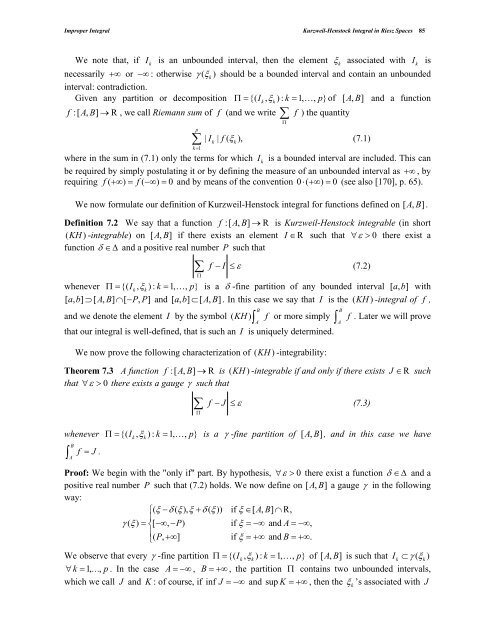Kurzweil-Henstock Integral in Riesz spaces - Bentham Science
Kurzweil-Henstock Integral in Riesz spaces - Bentham Science
Kurzweil-Henstock Integral in Riesz spaces - Bentham Science
You also want an ePaper? Increase the reach of your titles
YUMPU automatically turns print PDFs into web optimized ePapers that Google loves.
Improper <strong>Integral</strong> <strong>Kurzweil</strong>-<strong>Henstock</strong> <strong>Integral</strong> <strong>in</strong> <strong>Riesz</strong> Spaces 85<br />
We note that, if I k is an unbounded <strong>in</strong>terval, then the element ξ k associated with I k is<br />
necessarily +∞ or −∞ : otherwise γ ( ξ k ) should be a bounded <strong>in</strong>terval and conta<strong>in</strong> an unbounded<br />
<strong>in</strong>terval: contradiction.<br />
Given any partition or decomposition Π = {( Ik, ξk)<br />
: k = 1, …, p}<br />
of [ A, B]<br />
and a function<br />
f : [ A, B]<br />
→R , we call Riemann sum of f (and we write ∑ f ) the quantity<br />
p<br />
∑ | Ik | f( ξk)<br />
,<br />
(7.1)<br />
k = 1<br />
where <strong>in</strong> the sum <strong>in</strong> (7.1) only the terms for which I k is a bounded <strong>in</strong>terval are <strong>in</strong>cluded. This can<br />
be required by simply postulat<strong>in</strong>g it or by def<strong>in</strong><strong>in</strong>g the measure of an unbounded <strong>in</strong>terval as +∞ , by<br />
requir<strong>in</strong>g f( +∞ ) = f(<br />
−∞ ) = 0 and by means of the convention 0( ⋅ +∞ ) = 0(see<br />
also [170], p. 65).<br />
We now formulate our def<strong>in</strong>ition of <strong>Kurzweil</strong>-<strong>Henstock</strong> <strong>in</strong>tegral for functions def<strong>in</strong>ed on [ A, B]<br />
.<br />
Def<strong>in</strong>ition 7.2 We say that a function f : [ A, B]<br />
→R is <strong>Kurzweil</strong>-<strong>Henstock</strong> <strong>in</strong>tegrable (<strong>in</strong> short<br />
( KH ) -<strong>in</strong>tegrable) on [ A, B]<br />
if there exists an element I ∈ R such that ∀ ε > 0 there exist a<br />
function δ ∈Δ and a positive real number P such that<br />
∑ f − I ≤ ε<br />
(7.2)<br />
Π<br />
whenever Π= {( Ik, ξk)<br />
: k = 1, … , p}<br />
is a δ -f<strong>in</strong>e partition of any bounded <strong>in</strong>terval [ ab , ] with<br />
[ ab , ] ⊃ [ AB , ] ∩[ − PP , ] and [ ab , ] ⊂ [ AB , ] . In this case we say that I is the ( KH ) -<strong>in</strong>tegral of f ,<br />
and we denote the element I by the symbol ( ) B<br />
KH ∫ f or more simply<br />
A<br />
B<br />
∫ f . Later we will prove<br />
A<br />
that our <strong>in</strong>tegral is well-def<strong>in</strong>ed, that is such an I is uniquely determ<strong>in</strong>ed.<br />
We now prove the follow<strong>in</strong>g characterization of ( KH ) -<strong>in</strong>tegrability:<br />
Theorem 7.3 A function f : [ A, B]<br />
→R is ( KH ) -<strong>in</strong>tegrable if and only if there exists J ∈ R such<br />
that ∀ ε > 0 there exists a gauge γ such that<br />
∑ f − J ≤ ε<br />
(7.3)<br />
Π<br />
whenever Π= {( I , ξ ) : k = 1, … , p}<br />
is a γ -f<strong>in</strong>e partition of [ A, B]<br />
, and <strong>in</strong> this case we have<br />
∫<br />
B<br />
A<br />
f J =<br />
.<br />
k k<br />
Proof: We beg<strong>in</strong> with the "only if" part. By hypothesis, ∀ ε > 0 there exist a function δ ∈Δ and a<br />
positive real number P such that (7.2) holds. We now def<strong>in</strong>e on [ A, B]<br />
a gauge γ <strong>in</strong> the follow<strong>in</strong>g<br />
way:<br />
⎧(<br />
ξ − δ( ξ) , ξ + δ( ξ)) if ξ∈<br />
[ AB , ] ∩ R,<br />
⎪<br />
γξ ( ) = ⎨[<br />
−∞,− P) if ξ=−∞<br />
andA=−∞,<br />
⎪<br />
⎩(<br />
P,+∞ ] if ξ =+∞ andB=+∞.<br />
We observe that every γ -f<strong>in</strong>e partition Π = {( Ik, ξk)<br />
: k = 1, … , p}<br />
of [ A, B]<br />
is such that Ik ⊂ γ ( ξk)<br />
∀ k = 1,<br />
…, p.<br />
In the case A =−∞, B = +∞ , the partition Π conta<strong>in</strong>s two unbounded <strong>in</strong>tervals,<br />
which we call J and K : of course, if <strong>in</strong>f J = −∞ and sup K = +∞ , then the ξ k ’s associated with J<br />
Π

















